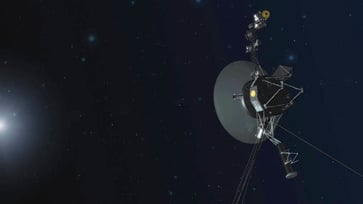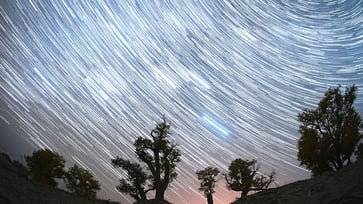NASA spacecraft to investigate Jupiter's icy moon for life-sustaining environments
NASA's largest spacecraft for studying another planet, the Europa Clipper, will be launched on a SpaceX Falcon Heavy rocket.

- The Europa Clipper, a spacecraft from NASA, is scheduled to investigate Europa, Jupiter's moon, which is a top contender for harboring life beyond our planet.
- Europa's icy crust conceals an ocean, and the Europa Clipper will evaluate if these conditions are suitable for life to exist.
- NASA's largest spacecraft for studying another planet will be launched on a SpaceX Falcon Heavy rocket.
An NASA spacecraft is prepared to embark on a journey to Jupiter and its moon Europa, which is considered a top contender for discovering life beyond our planet.
The Europa Clipper spacecraft will investigate the possibility of an ocean beneath the moon's icy crust, without searching for life, but rather assessing the conditions that could support it. A separate mission would be required to detect any microorganisms that may exist there.
Curt Niebur, program scientist, stated that it is an opportunity for us to investigate not a world that could have been habitable in the past billions of years, but a world that may be habitable presently.
NASA's Clipper, with its large solar panels, is the largest spacecraft constructed to explore another planet. It will take 5 1/2 years to reach Jupiter and will get closer to Europa's surface than any other spacecraft, at 16 miles.

This month, SpaceX's Falcon Heavy rocket will launch from NASA's Kennedy Space Center, with a targeted liftoff, at a cost of $5.2 billion for the mission.
Europa, the superstar among Jupiter’s many moons
Europa, one of Jupiter's 95 known moons, is almost the size of our own moon and is encased in an ice sheet estimated to be between 10 and 15 miles thick. Scientists believe that this frozen crust hides an ocean that could be 80 miles or more deep. The Hubble Space Telescope has spotted what appear to be geysers erupting from the surface. Discovered by Galileo in 1610, Europa is one of the four so-called Galilean moons of Jupiter, along with Ganymede, Io and Callisto.
Seeking conditions that support life
What kind of existence could Europa potentially host? Besides water, life as we understand it requires organic compounds and an energy source. Europa's thermal vents on the ocean floor could serve as these necessities. Deputy project scientist Bonnie Buratti envisions any life that exists in Europa would be rudimentary, similar to the bacterial life that emerged from Earth's deep-sea vents. "We won't be able to determine this from this mission because we can't see that far," she stated. Unlike missions to Mars, where habitability is just one of many concerns, Clipper's primary objective is to ascertain whether Europa's ocean or any pockets of water in its ice could support life.
Supersized spacecraft
Clipper, a spacecraft designed to explore Jupiter and its moons, is approximately the size of a basketball court when its solar wings and antennas are deployed. It weighs nearly 13,000 pounds and is equipped with nine science instruments, including radar, cameras, and tools to study Europa's surface and atmosphere. The name Clipper is inspired by the swift sailing ships of old.

Circling Jupiter to fly by Europa
The spacecraft's journey to Jupiter will be a roundabout trip that spans 1.8 billion miles. To add more power, it will pass Mars early next year and Earth in late 2026. It will arrive at Jupiter in 2030 and begin science work the following year. While orbiting Jupiter, it will cross paths with Europa 49 times. The mission will end in 2034 with a planned crash into Ganymede, Jupiter's largest moon and the solar system's largest moon.
Europa flybys pose huge radiation risk
Jupiter has the highest levels of radiation in our solar system, except for the sun. Europa, one of Jupiter's moons, passes through Jupiter's radiation bands as it orbits, making it dangerous for spacecraft. To protect Clipper's electronics, they are enclosed in a vault with thick aluminum and zinc walls. While this radiation could potentially harm any life on Europa's surface, it may also break down water molecules and release oxygen, which could support sea life in the ocean below.
NASA faced a dilemma earlier this year when they feared the spacecraft's transistors may not withstand intense radiation. However, after extensive analysis, engineers determined the mission could proceed as planned.

Other visitors to Jupiter and Europa
In the 1970s, NASA's Pioneer spacecraft and two Voyagers passed Jupiter. The Voyagers captured the first detailed photos of Europa from a distance. NASA's Galileo spacecraft flew by Europa multiple times during the 1990s, getting as close as 124 miles. Currently, NASA's Juno spacecraft is still active around Jupiter, adding to Europa's photo collection. The European Space Agency's Juice spacecraft, launched last year, will arrive at Jupiter a year after Clipper.
Ganymede and other possible ocean worlds
Ganymede, Jupiter's large moon, is believed to have an underground ocean, but its thick frozen shell, estimated to be 100 miles thick, makes it difficult to probe the environment below. Callisto's ice sheet may be even thicker, concealing an ocean. Enceladus, one of Saturn's moons, has geysers erupting from its surface, while Titan, another Saturn moon, is also suspected of having a subterranean sea. Although no ocean worlds have been confirmed beyond our solar system, scientists believe they exist and may be relatively common.
Messages in a cosmic bottle
The triangular metal plate attached to the electronics vault of Clipper carries messages from Earth. On one side, it features the word for water in 104 languages, while on the other side is a poem by Ada Limon about the moon and a silicon chip with the names of 2.6 million people who signed up for the ride-along experience.
science
You might also like
- Lunar modules from the first two moon landings have been captured in stunning detail by Orbiter photos, more than 50 years after the historic missions.
- Discovery of a remarkable mastodon jaw in a New York homeowner's backyard
- NASA resumes communication with Interstellar Voyager 1 after pause.
- In 2055, the asteroid that was once referred to as Earth's "mini moon" will make a return visit.
- A new species of sea slug that resides in the ocean's 'midnight zone' has been discovered with a glowing appearance.



















